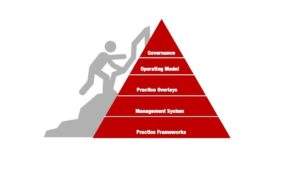
A post by our guest editor, John Worthington. A follow-up to part 1 – The Mountaintop Fallacy – this is part 2. What Each Layer Really Does Overlays, Operating Models, and Practices—Stop Mixing Your Metaphors You’ve seen the slide. One of those strateg…
Read more »“Capabilities represent what the business does, 𝐧𝐨𝐭 𝐡𝐨𝐰 𝐢𝐭 𝐝𝐨𝐞𝐬 𝐢𝐭.”. Or rather “Capabilities represent what the business wants to do”. This is typically a modeling act, creating an abstract image of what the company does. As such – it’s crucial for ar…
Read more »

Layered models are extremely popular in the world of architecture. This started with PRISM in 1986, and was followed up with Zachman (1987), and NIST (1989). In 1993, the Strategic Alignment Model (SAM) of Henderson & Venkatraman and the BDAT model…
Read more »

Einstein once said: “You cannot solve problems with the same actions that caused it”. In other words: “if you do what you did, you get what you got”. This means that – if you want to solve the ever-growing complexity in service organizations, you’ll ha…
Read more »

In practice, architects are often builders, developers. So then they are butchers who are testing their own meat. Why doesn’t an architect confine himself to his primary role: designing and managing a set of rules and guidelines that contribute to cons…
Read more »

We all do it. You do it. Your neighbor does it. Your co-workers do it. Your family does it. Your consultants do it. You even learned it in school from your teacher. PTO – Polishing the Outside. We’ve been doing it for decades. All over the world. You c…
Read more »

It seems that most architects are now also designers as well as developers, and spend more energy discussing and describing the technology results than discussing the principles and methods that make architecture. In my world, architecture should start…
Read more »

ICT regulators and controllers tend to follow a rule-based approach. Although – if asked – they soon enough admit that they actually don’t believe it is the right approach. They would love to see their target audience being so well organized that they…
Read more » 






